Hatches, Sierra Tahoe – the best match for the hatch

Below is a suggested a hatch chart for Hatches, Sierra Tahoe. Keep in mind that the time of insect emergence will fluctuate based upon weather conditions, run-off, water temperatures, and elevation. It is a general forecast not a specific one.
| January | Feburary | March | April | May | June | July | August | September | October | November | December |
Skwala Stonefly | Slight | Major | Minor | |||||||||
Nymphs | Brook’s Yellow Stone , Sexstone Nymph, Twenty Incher | |||||||||||
Dries | Yellow Stimulator, Madam X | |||||||||||
| Also known as Brown Willow Fly | Skwala, These are the first stoneflies of the Spring. They have only recently been recognized since many fly fishermen had mistaken them for an early emergence of Golden Stones. The nymphs have a Olive Brown to Dark Brown coloration with a lighter Pale Yellow color on the underside. They reside in rivers and streams of fast-moving waters with gravel bottoms. They hatch according to the water temperatures. Water temperatures need to reach 45 to 47 degrees to commence emergence. The nymphs will travel along the bottom and ascend onto vegetation or rocks. The trout will often concentrate their attention on the shallow, faster-moving waters, so look where you are standing, this may be the prime waters to fish. Mating will proceed along the banks and the females will hover along the water surface to deposit eggs. The male adults have no wings and remain within the vegetation. Female adults are Olive-Brown to Olive-Yellow in body color. Nymphs are generally fished with size #10-12 and the adults are fished with size #8-12. Within the Sierra Tahoe area, the NF Yuba River has a consistent hatch. | |||||||||||
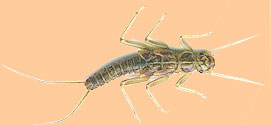 | 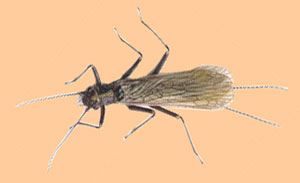 | |||||||||||
 | ||||||||||||
| January | Feburary | March | April | May | June | July | August | September | October | November | December |
| Minor | Major | ||||||||||
Nymphs | Brown Kaufmann Stone, Bird’s Stonefly Nymph, Brook’s Stone, Black | |||||||||||
Dries | Improved Sofa Pillow, Orange Stimulator Giant Rogue Foam Stone | |||||||||||
Pteronarcys, these nymphs live 2-4 years in the water. They seek streams with moderate to fast currents and live within riffles and boulder areas. In Spring, the larvae crawl up to the banks and out of the water to transform into adults. Often they fall back into the water. The adults are large, 2 1/2 inches, with two pairs of wings and an orange body. Adult activity is in May and June and can last a few days to three weeks. The hatch will start when the water warms up, usually late morning, and will work itself upstream. Female adults will often deposit their eggs by dropping down to the water during the late afternoon or early evening. After depositing the eggs, many females end up in the water starting a feeding frenzy among the trout. Nymphs can be used year-round with larvae activity is best in the Spring and Fall. In the Sierra Tahoe area, salmonfly hatches occur on the Middle Fork and North Fork of the Feather River as well as the NF Yuba and EF Carson. Further north (oustide of the Sierras), the McCloud, Pit and Klamath are good salmonfly rivers. | ||||||||||||
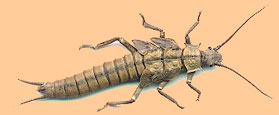 | 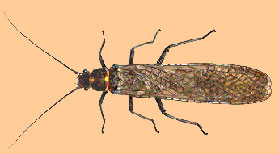 | |||||||||||
 | ||||||||||||
| January | Feburary | March | April | May | June | July | August | September | October | November | December |
Golden Stonefly | Minor | Major | Major | Slight | ||||||||
Nymphs | Golden Kaufmann Stone, Brook’s Golden Stone , Mercers Biot Epoxy Golden Stone | |||||||||||
Dries | Gold Stimulator, Improved Sofa Pillow , Rogue Foam Stone, | |||||||||||
Calineuria, The nymphs are large, 1.5 to 2 inches, and live in rocky riffles with moderate to fast water. They are a mottled color of tan, black, and brown. The nymphs crawl onto exposed rocks and emerge. Females return in late afternoon to lay eggs. Adult activity is in May and June and can last 2 weeks to a month. Nymphs can be fished throughout the year with larvae activity best in the Spring and Fall. Good hatches on EF Carson (July – Sept), Feather and Truckee (June-July). | ||||||||||||
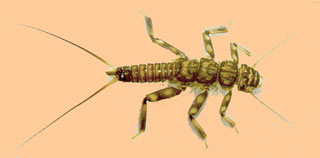 | 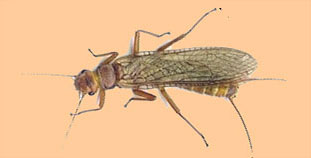 | |||||||||||
 | ||||||||||||
| January | Feburary | March | April | May | June | July | August | September | October | November | December |
Little Yellow Stone | Major | Major | Slight | |||||||||
Nymphs | Little Yellow Stone Nymph | |||||||||||
Dries | Yellow Humpy, Clark’s Little Yellow Stonefly, Ride Sally Ride, Headlight Sally | |||||||||||
Isoperla, these are small (1/4 to 1/2 inch) light tan to bright yellow stoneflies that hatch in late Spring to late Summer. Usually found in mid- to high-elevation streams with rocky bottoms and fast currents. Like typical stoneflies, the larvae crawl upon the rocks and emerge from their shucks at dawn, sometimes dusk. The adults take to air flight as the temperatures rise. Males and females converge during the day mating. Females return in late afternoon and through the evening hours laying eggs. Good hatches on the East Carson (June-Sept), Feather River (May-July), and Truckee (June-Aug). | ||||||||||||
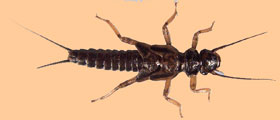 | 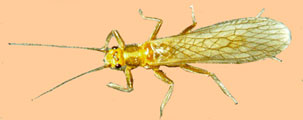 | |||||||||||
 | ||||||||||||
| January | Feburary | March | April | May | June | July | August | September | October | November | December |
Damselfly | Minor | Major | Major | Minor | Minor | Slight | ||||||
Nymphs | Marabou Damsel , Sierra Damsel , Wiggle Tail | |||||||||||
Dries | Burk’s Damselfly , Stalcup’s Blue Damselfly | |||||||||||
Zygoptera, Damselflies prefer lakes and ponds but will also be found in slow moving streams . The nymphs hatch from eggs laid on subsurface plant material. They move through the water at a slow pace by undulating it’s entire body. Below the abdomen are three gills which also help create movement. Usually the nymph will hang within the water column so that a Chuck and Sit Presentation will generally be more successful than retrieves. The colors of the nymph will vary from Green to Olive to Brownish hues depending upon the time of year. The adult rests with it’s wings folded over it’s body. Female damsels lay their eggs by crawling down plant material into the subsurface environment. She carries a volume of air trapped by her body to respire and will be carried by the air bubble to the surface after laying the eggs. Trout will key in on this since many adults get trapped within the surface film. Good hatches at Davis Lake and Frenchman Reservoir. | ||||||||||||
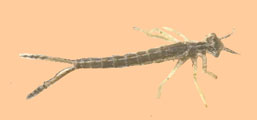 |  | |||||||||||
 | ||||||||||||
| January | February | March | April | May | June | July | August | September | October | November | December |
| Minor | Minor | Major | Major | Slight | |||||||
Nymphs | Emergent Sparkle Pupa, Anderson’s Bird of Prey Olive, Z Wing Caddis, Fox’s Poopah Olive | |||||||||||
Dries | Olive Elk Hair Caddis, Partridge Caddis Emerger, X-Caddis Olive, E/C Caddis | |||||||||||
Wet Flies | Hare’s Ear, Leadwing Coachman | |||||||||||
| Also known as Summer Caddis or Net Spinning Caddis | Hydropsychid, A Net-spinning caddis whose larva, similar to Green Rockworms, are available through most of the year within moving streams. Usually pale green or tan, these caddis spin silky nets in the crevices of rocks using bits of materials available within the stream. The larvae can be fished throughout the year. Adults hatch in July by pupa coming to the surface with a bubble of gas. 1-3 three weeks later, females will swim down underwater to lay eggs. The Leadwing Coachman or Hare’s Ear is used as a wet fly to imitate this ability. Spotted Sedges are most often found within riffles and runs. Caddis are present in almost every stream. During the early evening hours, what appears as a massive hatch, is actually the females depositing eggs. Wet flies can be your best bet during these hours. Good hatches are within NF and MF Feather (June-Sept), Truckee (June-Sept), MF and SF American (June-Sept), North Fork Yuba (June-Sept), and EF Carson Rivers (June-Oct). | |||||||||||
 |  | |||||||||||
 | ||||||||||||
| January | February | March | April | May | June | July | August | September | October | November | December |
| Major |
| ||||||||||
Nymphs | Tangerine Dream, Red Fox Squirrel, Bill’s Stick Caddis , Brown and Orange Emergent Sparkle Pupa | |||||||||||
Dries | Orange Stimulator, Orange Parachute Madam X | |||||||||||
Dicosmoecus atripes, October Caddis hatches start in early September and peak in early October. They inhabit freestone streams and some tailwaters with medium to strong currents. You will not find them in streams with silty bottoms. The larvae migrate close to shore just before pupation and will form colonies. The larval case for pupation will be made up of pebbles and the new pupa will emerge and crawl or swim towards shore, climbing rocks and vegetation. Try fishing the banks near vegetation. They will not swarm but you will notice individuals as they are big. After mating, the females will lay eggs in the water near the edges of the streams in early to late afternoon. Most dry fly presentations are made with a dead drift using a Direct Upstream method. If this does not work well, try skating the fly working the riffles and current seams. Good hatches are on the Truckee, NF Yuba, and East Fork of the Carson River. | ||||||||||||
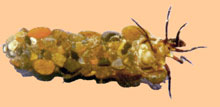 | 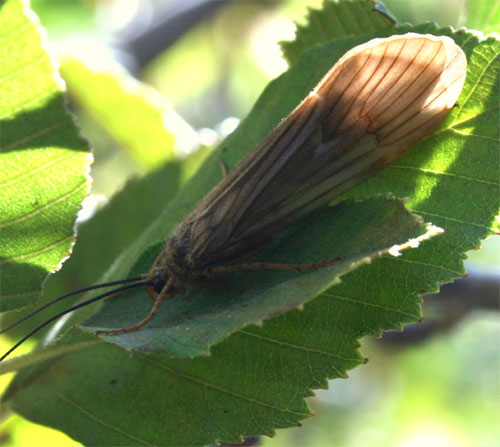 | |||||||||||
 | ||||||||||||
| January | Feburary | March | April | May | June | July | August | September | October | November | December |
Green Sedge Caddis | Slight | Major | Major | Minor | Slight | |||||||
Nymphs | Emergent Sparkle Pupa, Bird’s Nest , | |||||||||||
Dries | Olive Caddis, Z-Wing Caddis , Hemingway Caddis , Olive X-Caddis | |||||||||||
| Also known as Gray Sedge | Rhyacophila, As you’d expect, it’s green and looks like a worm in the larva stage. The larvae live in fast-current freestone streams. They prefer riffle areas with rocky streambeds and good aeration. The larvae are predaceous and will hunt for mayfly and midge larvae among the rocky bottoms. Often the larvae are swept into the current and are available to the trout. The larvae makes a shelter to pupate, then cuts itself free to ascend to the surface. During this ascent, the olive-colored pupa (size 10-16) are extremely vulnerable to the trout, and they immediately free themselves of their shuck to become adults. Cripples and emerger patterns are ideal during this stage. Adults will hatch in the afternoon from June to August. The adults tend to be dark tan to green, almost black in sizes 12-16. This caddis offers many opportunities for dry flies since the adult likes to land on the water surface weeks after hatching and swim to the bottom to lay eggs. Wet flies are a good choice to mimic the swimming action of the adult. Good hatches on the EF Carson, Truckee. | |||||||||||
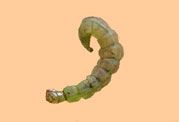 | 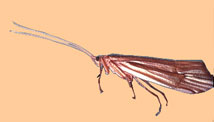 | |||||||||||
 | ||||||||||||
| January | Feburary | March | April | May | June | July | August | September | October | November | December |
Saddle Casemaker | Slight | Minor | Major | Major | Minor | |||||||
Nymphs | Tan Bird’s Nest , Ginger Emergent Sparkle Pupa, Ginger Deep Sparkle Pupa , GB Tan Poopah | |||||||||||
Dries | Elk Hair Caddis, Tan X-caddis, Tan E/C Caddis | |||||||||||
Glossoma, these are small case-type caddis with a dome-like case made of pebbles firmly attached to rocks. The larvae outgrow the cases and must discard the old case to build a new, larger one. This action occurs on a weekly basis, usually under low light conditions such as early morning or dusk, and leaves the larvae vulnerable to trout. Found in moderate- to fast-current shallow streams. The larvae themselves are cream-colored while the adults are a light tan or brown. The larvae will undergo a pupation prior to becoming an adult. The pupa will be orange colored and will swim within the slower waters below the riffles. After two days, the pupa will rise to the surface about an hour after sunset and emerge as an adult. The female adults swim back down to lay eggs on the stream bottom just after sunset. Time your fly selection according to the rises. During a rise, work an emerger pattern (size 16) with an Across and Down presentation just below the surface. After the rises end, switch to a deep sparkle pupa using a Dead Drift presentation. The dry fly (size 16) can be used after the hatch ends and also throughout the day. Good hatches on the Truckee, and EF Carson (July-Sept). | ||||||||||||
 |  | |||||||||||
 | ||||||||||||
| January | February | March | April | May | June | July | August | September | October | November | December |
Grannom | Minor | Major | Minor | Minor | Minor | Major | ||||||
Nymphs | Olive Hare’s Ear Soft Hackle , Emergent Sparkle Pupa , Fox’s Springtime Poopah, Morrish’s Hot Wire Caddis, Prince Nymph | |||||||||||
Dries | Olive Caddis, E/C Caddis, X-Caddis Olive , Partridge Caddis Emerger, CDC & Elk | |||||||||||
| Also known as Mother’s Day Caddis or American Grannom (Black Caddis) | Brachycentrus, This is a case-making Caddis that creates chimney-like cases composed of pine needles, bark, or other plant material. The cases are often 4-sided with distinct corners. The larvae lay inside the case, often green with a black head. The caddis live in moderate to fast riffle areas of streams and anchor themselves to rock or twigs with a white silky thread. The larvae will feed upon algea on the rocks or floating within the current. They will use the thread to position themselves into good feeding areas of the stream current. Fly fishermen will use a white grease pen to mark about 12 inches of the tippet to imitate this thread. Pupation occurs during late Spring and early Summer, once the water temps exceed 50 degrees. The pupa will crawl along the stream bottom and let the currents carry them to the surface, often upon a bubble. The trout will key on this emergence. Use a Across and Down presentation just dragging beneath the surface with a few twitches. The adults will come back to the stream late afternoon, after mating, to lay eggs. They will lay eggs on the surface if they can’t break the surface tension, others manage to swim down and attach the eggs to underwater objects. These adults will usually become spent upon the surface. There are two species, the Mother’s Day Caddis (B.occidentalis) hatches in April through July and the American Grannom (B. americanus) hatches in the Fall during September and October. Hatches usually occur in the afternoon and early evening. The Caddis Mother’s Day hatch is during early May and will start within the lower elevations during the pre-runoff moving up into the higher elevations by early June. Heavy spring runoff can discontinue the hatch. Good hatches on EF Carson (July-Aug), Feather and Yuba (April-Aug). | |||||||||||
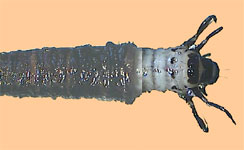 | 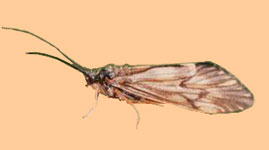 | |||||||||||
 | ||||||||||||
| January | Feburary | March | April | May | June | July | August | September | October | November | December |
Chironomids | Slight | Slight | Slight | Slight | Major | Major | Major | Minor | Minor | Minor | Slight | Slight |
Nymphs | Zebra Midge , Optimidge, WD-40, TDC | |||||||||||
Dries | ||||||||||||
Chironomidae, There are over 45 genera of chironomids in California alone. For our purposes, group them into Chironomids and Bloodworms. Both are found in lakes, ponds, and slow-moving streams such as Spring Creeks. Within the Sierras, they are prevalent within our alkaline lakes on the Eastside. Bloodworms are so-named since they carry hemoglobin which allows the insect to survive in poorly oxygenated water such as lake bottoms. Chironomids can be found in a number of colorations from Black, Olive, Gray, and Tan. The densities of these larvae can exceed fifty thousand per sq. meter of lake bottom. Emergence occurs year-round. The larvae frees itself from the mud burrows and rise to the surface with a gas-filled pupal sheath. The pupa breaks through the water surface and an adult emerges to fly away. Trout will feed on the ascending pupae primarily within the lower water column, perhaps 6-12 inches off the bottom. During low light conditions, such as evening, the trout will feed upon the emergers near the surface. Good Hatches occur at Martis Lake, Davis Lake, Milton Lake, and Frenchman Reservoir. | ||||||||||||
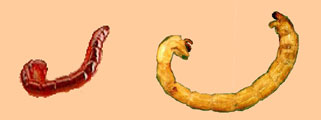 |  | |||||||||||
 | ||||||||||||
| January | February | March | April | May | June | July | August | September | October | November | December |
Scuds | Slight | Minor | Major | Major | Minor | |||||||
scuds | ||||||||||||
Grammarus & Hyaella , Scuds are freshwater shrimp that inhabit lakes, ponds , rivers, and Spring Creeks. They can be especially dense within alkaline lakes up to ten thousand scuds per cubic meter. As the water becomes more clear and sterile, the scuds will decrease in numbers. Generally, they prefer shallow areas with plenty of weed cover. Colorations can vary from Olive to Grey to Bright Orange. Scuds swim through the water with a straight profile and bend when they are in a resting mode among vegetation. Since they are available to trout year-round, the important periods are often when other food sources have declined, such as the Fall and Winter. Good Scud areas are Truckee River, and Frenchman Reservoir, | ||||||||||||
 | ||||||||||||
 | ||||||||||||
| January | February | March | April | May | June | July | August | September | October | November | December |
Pale Morning Dun | Minor | Major | Major | Minor | ||||||||
Nymphs | Burk’s Hunchback Infrequens, Pheasant Tail Nymph, PMD Halfback Emerger, PMD Emerger | |||||||||||
Dries | PMD Parachute Dun, PMD Sparkle Dun, PMD Quigley Cripple, CDC PMD Cripple Dun | |||||||||||
Ephemerella infrequens and E.inermis, PMD’s hatch mainly in June and July in the morning or evening. They are Crawler-type mayflies that like to emerge in water temperatures of 55 to 60 degrees. A hatch may occur midday when the weather is overcast. The adult insect has a pale green to yellowish body with pale gray wings in the size of 14-16. The nymphs are olive-brown with three tails and rectangular bodies. Inermis will hatch first followed by Infrequens. The nymphs will slowly swim to the surface during the time of emergence. They often get trapped within the surface film prior to emerging as a dun. PMD’s reside in the riffles, runs, and flats of moderate streams. Good PMD areas are the Truckee (June & July), Little Truckee (May through Aug), North Yuba (July), and Lower Yuba (May through June), EF Carson ((July-Sept), Feather (June-July). | ||||||||||||
 | 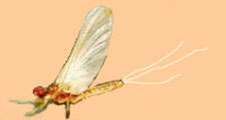 | |||||||||||
 | ||||||||||||
| January | February | March | April | May | June | July | August | September | October | November | December |
Trico | Slight | Minor | Major | Minor | Slight |
| ||||||
Dries | Trico Spinner, Trico Quilled Parachute | |||||||||||
Tricorythodes, Tricos are members of the Crawler-type mayflies found on slower portions of streams, particularly Meadow streams and Spring Creeks of silty bottoms within the Sierra. They have a long emergence period, peaking in July. Most Tricos emerge as duns underwater and float up to the surface. Trico males hatch at night and the females hatch in early morning. After mating, Spinners of both sexes fall at the same time around mid- to late-morning. The spinners can be identified with a dark body of 1/8-1/4 inches, white wings and long tri-tail. Most fly fishermen concentrate on the spinner-fall. Use a long leader of 12-14 feet with 3 feet of 6x tippet. The spinner pattern must be within the feeding lane with a drag-free drift. See Up and Across presentation. Good Spinner falls on the EF Carson River (July-Aug), Truckee (July-Sept), . | ||||||||||||
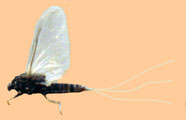 | ||||||||||||
 | ||||||||||||
| January | February | March | April | May | June | July | August | September | October | November | December |
Western Green Drake | Slight | Major | Slight | |||||||||
Nymphs | Poxyback Green Drake, Gold Ribbed Hare’s Ear , Floating Nymph | |||||||||||
Dries | Green Drake Quigley Cripple, Green Drake Parachute Dun , Yellow Humpy | |||||||||||
Drunella grandis, Western Green Drakes are poor swimmers and have considerable trouble in emerging at the surface. Often, they will make multiple trips to surface prior to emerging. They are Crawler-type mayflies which prefer medium-fast riffle areas of freestone streams. Thus, cripple patterns are very useful for this hatch. Emergence usually takes place in the late afternoon or evening. Guide Frank Pisciotti reported seeing the Green Drakes in early June on the Truckee and late June on the Little Truckee in 2004. The hatch period can be a short duration of only 7-10 days. Spring Creeks will often have the hatch a few weeks earlier than freestone streams. The larvae are dark reddish-brown and blocky in shape. The dun is the most important stage of the hatch since they have to spend a minute or more drying on the surface. It can be recognized by having three tails and an olive-green back with soft green on the underside, 1/2 to 3/4 inches in size. Distinct yellow bands are between the abdomen segments. Good hatches on the Feather (June-July), Truckee (May-June). | ||||||||||||
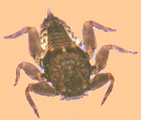 | 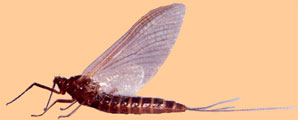 | |||||||||||
 | ||||||||||||
| January | February | March | April | May | June | July | August | September | October | November | December |
March Brown | Slight | Major | Minor | |||||||||
Emerger | Pheasant Tail Soft Hackle , Gray Hackle Peacock | |||||||||||
Dries | Bivisible Dun , Royal Humpy, March Brown Comparadun, March Brown Parachute Dun | |||||||||||
Rithrogena, March Browns hatch from April to June for a 4-6 week period. They are members of the Clinger Mayflies which cling to the bottom as larvae. March Brown nymphs have a unique ability to use their gills as suction cups and are difficult to dislodge, thus most trout do not find the nymphs as an available food source. The nymphs emerge as duns underwater rather than at the surface. This action makes them extremely vulnerable to trout as they spend several minutes at the surface drifting while the wings dry. March Browns like to pick nice cold drizzly days to make their appearance in the early afternoon with the hatch lasting 3-4 hours. The larvae are found in fast riffles of freestone streams and will migrate, prior to emergence, to calmer areas. Since the nymphs cling to the streambed, they are usually not available to the trout, so emergers and dun patterns are your best bet. The duns will have a reddish brown body on the top and a cream or light brown on the bottom. The size is 1/4 to 5/8 inches. Good Hatches on EF Carson and Truckee (May-June), | ||||||||||||
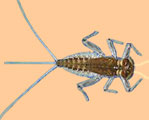 |  | |||||||||||
 | ||||||||||||
| January | February | March | April | May | June | July | August | September | October | November | December |
Little Yellow May | Major | Minor | ||||||||||
Emergers | Pheasant Tail Soft Hackle , Gray Hackle Yellow | |||||||||||
Dries | Bivisible Dun , Yellow Humpy | |||||||||||
Epeorus, Little Yellow Mays (also known as Sulfur Duns) hatch from June to July. They are members of the Clinger Mayflies and have the same emergent attributes as March Browns. The numbers of these Mayflies within the stream are considerably larger than the March Browns and the other Clinger Mayflies. They are the only Mayfly nymphs with two tails. The emerger and dun will have a pale cream to yellow body. The size will be 1/4 to 3/4 inches. The larvae live in the same habitat as the March Browns, fast and turbulent riffles. They will generally hatch just after the March Browns complete their hatch, so you can use many of the same patterns and techniques. Good Hatches on the EF Carson (May-July), Truckee (June-July). | ||||||||||||
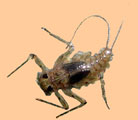 | 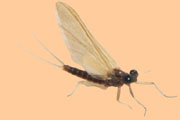 | |||||||||||
 | ||||||||||||
| January | February | March | April | May | June | July | August | September | October | November | December |
Pale Evening Dun | Minor | Slight | ||||||||||
Nymphs | Gold Ribbed Hare’s Ear , Pheasant Tail Nymph , Bird’s Nest | |||||||||||
Dries | Bivisible Dun , Yellow Humpy | |||||||||||
Heptagenia, Pale Evening Duns hatch from mid-May to late July, usually in the afternoon or evening. They are not numerous and can be site specific. Guide Ralph Cutter has found them on the Truckee River in May. PED’s are members of the Clinger Mayflies but they differ from many Clinger-type mayflies in that they inhabit the slower portions of freestone streams such as slow riffles, eddies and pools. Since the turbulence is not great, the nymphs will migrate up to the surface film and emerge. The use of nymph patterns work well during these hatches. Emergence can take several minutes with cooler days delaying the time necessary to fly away. The nymphs have three tails and are 1/4 to 1/2 inch long, with colors of light olive-brown to dark brown. The duns are 1/4 to 5/8 inch long and have a creamish white to reddish brown color. | ||||||||||||
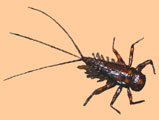 | 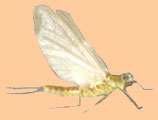 | |||||||||||
 | ||||||||||||
| January | February | March | April | May | June | July | August | September | October | November | December |
Blue Winged Olive | Minor | Major | Major | Major | Minor | Slight | ||||||
Nymphs | Pheasant Tail Nymph, RS2 BWO, Halfback Emerger BWO, Poxyback Nymph BWO, Barr’s BWO Emerger, Brook’s Baetis Sprout | |||||||||||
Dries | BWO Sparkle Dun, BWO Parachute Dun, Blue Wing Olive, Hackle Stacker BWO, Baetis Quigley Cripple, BWO CDC Cripple | |||||||||||
Baetis, The BWO’s are members of the Swimming-type of mayflies. They start hatching in late September and peak in October. In low elevations, they’ll continue hatching through the Winter but in Sierra Tahoe they show up after snow melt in May and will continue into June. The hatches occur in the early afternoon , especially on drizzly days. Nymph activity is prevalent in the early morning and early evening hours. Baetis are dark olive with a gray wing. Most BWO’s are size 18-20 but size varies and it is important to match the size. The nymphs swim to the surface and often get stuck in the surface file. Cripples and Emergers are important patterns for this hatch. BWO’s will be found in all free-flowing streams and are heaviest in streams with stable flows such as tailwaters, meadow streams, and spring creeks. Good BWO areas are Little Truckee, Truckee, NF Feather, EF Carson, and Mokelumne rivers. | ||||||||||||
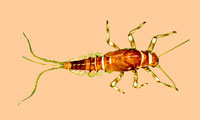 | 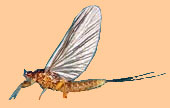 | |||||||||||
 | ||||||||||||
| January | Feburary | March | April | May | June | July | August | September | October | November | December |
Callibaetis | Major | Super | Major | Minor | Major | |||||||
Nymphs | Pheasant Tail Nymph, Poxyback Nymph & Emerger | |||||||||||
Dries | Callibaetis Cripple, Bivisible Dun , Callibaetis Quilled Parachute, AK’s Quilled Spinner | |||||||||||
Speckle-wing Mayfly, this mayfly prefers the quiet waters of lakes and ponds, particularly those stillwater with prevalent weedbeds. It is a Swimming-type mayfly. Generally they range from size 12 to 16 and come in colors of olive, tan, and brown. Hatches begin in late Spring, around May and continue through the Summer. The Late Spring hatch should be the larger sizes while the last Summer hatch will be your smallest size callibaetis. The hatches are best during overcast skies, or even rain. Generally, the major emergence periods are spaced about 6 weeks apart. Hatches usually start around 7:00 a.m. with nymphs congregating at the bottom. Around 11:00 a.m. and throughout the mid-day, concentrate on emerger patterns and dries. Spinner Falls can occur at any time during the morning hours. Use a Lift and Settle presentation for the nymphs. | ||||||||||||
 | 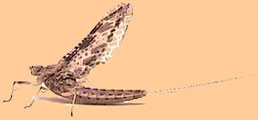 | |||||||||||
 | ||||||||||||
| January | February | March | April | May | June | July | August | September | October | November | December |
Gray Drake | Slight | Slight | Major | Slight | Slight | Slight | Slight | |||||
Nymphs | Pheasant Tail Nymph, Bird’s Nest | |||||||||||
Dries | Gray Cripple, Bivisible Dun , AK’s Quilled Spinner | |||||||||||
Siphlonurus, a Swimming-type mayfly that inhabits the edges of lakes and slow streams. The nymphs will emerge starting in April, peaking in June, often crawling up rocks and emerging plant material to become duns. Some emerge in open water with difficulty and are targeted by the trout. The nymphs are usually a size 10-12 and have a long slim profile that should require a 2x or 3x long hook shank. The body color can be light- to dark-gray. Spinners can be up to 7/8 inches long and have a body coloration of yellow-olive to black. Use a Count and Retrieve method for nymphing with short strips. Emerger patterns should use a Chuck and Sit presentation. Duns are not available to the trout since they fly away immediately but spinners can available in great numbers. Tahoe Fly fishing Outfitters reports a consistent hatch of Gray Drakes on the East Fork of Carson River in Sept and Oct. | ||||||||||||
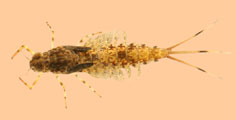 | 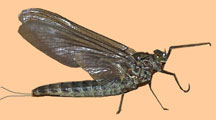 | |||||||||||
 | ||||||||||||
| January | February | March | April | May | June | July | August | September | October | November | December |
Slate Wing Mayfly | Minor | |||||||||||
Nymphs | Pheasant Tail Nymph, Bird’s Nest | |||||||||||
Ameletus, a Swimming-type mayfly that inhabits the the same habitat as Blue Wing Olives, small rapid streams, where they hug the banks. The main hatch occurs during the Spring in May. A unique species of Ameletus also inhabits the high elevation lakes within the Sierras which will hatch in June or July. The nymphs will crawl above the water on plant material or rocks to emerge as duns. The nymphs are light-brown to reddish-brown and a 1/2 inch size. Since spinner falls are very sporadic, nymphs will be the main opportunity to use. The duns have two tails and a yellowish-brown or pale olive coloration and is also about 1/2 inch in length. The nymphs are very quick so the best presentation is to cast along the shoreline with Count and Retrieve method using quick, short strips. | ||||||||||||
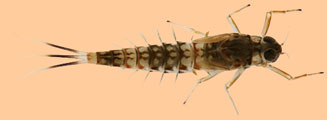 | 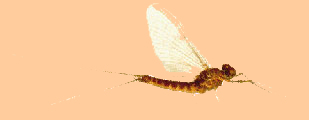 | |||||||||||
 | ||||||||||||
